#Dog & Puppy Vaccination
Explore tagged Tumblr posts
Text

Cute "cat + dog" logo for a petshop 🐶🐈🐾🧡
Get your unique & creative logo! Your brand visual identity is as much as important as marketing.
#dog#cat#petshop#petcare#logo#hello kitty#puppy#pet vaccines#pet care#negative space#modern#black and white#drawing#sketch#digital art#vector#illustration#artists on tumblr
39 notes
·
View notes
Text
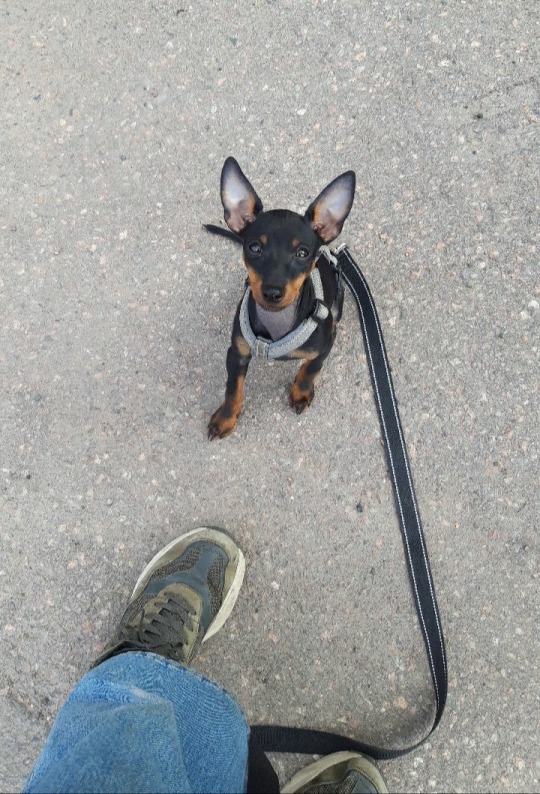
How can you say no to those eyes?
#someone got his first vaccine !#he was beimg very brave about it#being*#dog#dogblr#dogs#english toy terrier#puppy#puppies#terrier#terriers#cute#dogs of tumblr#pretty boy remi#12 weeks
72 notes
·
View notes
Note
Hi! I know that it's important to socialize a puppy well with both people and other dogs. But I also know you shouldn't let a puppy in contact with other dogs or walk it in areas where other dogs go before they have been fully vaccinated to prevent diseases.
Does that mean the socialization starts only after they get all their vaccines? Or is there something I'm missing here? Also because I thought the early periods of a dog's life were especially important with regards to socialisation.
Thanks!
Question tax: who was the cutest puppy you've seen recently?
vet-and-wild here.
It is no longer recommended to wait to start socializing a puppy until after their vaccine series is done, but you do need to take precautions. The reason is that there is a critical socialization window right in the middle of this time that ends around 16 weeks. That doesn't mean they can't learn or be socialized outside of this time, but the experiences they have in this time period are very important for setting the stage to how they react to stimuli in the future. Puppies who are improperly or under socialized during this period are much more likely to have behavioral issues as adults.
It's important to also understand why we booster puppy vaccines so many times. Depending on what kind of vaccines or disease exposure the mother had, this same time period is when the maternal antibodies the puppy received will be lost. Those maternal antibodies protect the puppy, but also interfere with vaccine efficacy. We don't know when they will lose the protection from those maternal antibodies, so we booster through this period to make sure they are protected. So just having 1 or 2 vaccines wouldn't guarantee that the puppy was fully protected.
The compromise is to avoid areas of potentially higher risk during this time. Dog parks, for example, may be full of dogs of unknown vaccine status and could have wildlife around that may carry parvo, distemper, etc. However, a puppy class at a reputable training facility only allows vaccinated dogs and should have disinfection protocols in place to help reduce the risk of disease spread. Basically, your puppy doesn't need to live in a bubble during this period, but you should use reasonable caution. Also keep in mind that socialization doesn't necessarily mean meeting a bunch of people or dogs! It just means positive exposure. Sitting out in your yard and practicing appropriate reactions to strange dogs walking by is socialization. Playing videos with thunder, fireworks, etc and getting the puppy used to it is socialization. Getting used to the car, medical handling, grooming, strangers coming in the house, all of that is part of socialization.
I tried to think of the cutest puppy I've seen but I'm going to be lame and say they're all cute cuz I keep changing my mind!
296 notes
·
View notes
Text
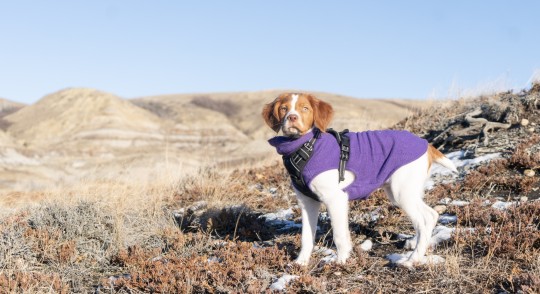
I forgot to do a Week 4 Recap post this week but she's crushing it.
#dogblr#rory borealis#she's honestly turning into such a cool little dog#we focused more on cooperative care and conditioning this week#since it was xmas so i wasnt motivated to go out#anyway we started pivots balancing exercises and proper positioning for square sits#also worked on combing clipping and nail grinding#this week's victory was really good name recognition and learning to ask for things (food training outside snuggles)#next week's goal is more neutrally around pinecone and starting on polite greetings (all four feet on the floor)#she has her last set of vaccines and starts one of her puppy classes and has a puppy grooming session#im excited to see what she learns from them
51 notes
·
View notes
Text
That cdc ruling is legit keeping me up at night. The more I read on it the more I feel all my future plans slipping through my fingers.
#dogblr#legit just crying#and crying#and idk what to do#my dogs are my kids my life my passion#my breeder is my friend my mentor#not to mention the ruling is super unclear is it considers Canadian vaccines valid to the ruling at ALL#so like…any hopes of a dog period not even a puppy just. whoosh. slipping through my fingers
20 notes
·
View notes
Text
sometiems im Like thinking to msyelf-> i got to stop embarrassing msyelf in peopels tags by being crazy all the time but like. This feeling is never strong enough to get me to stop. Whcih is completely useless
#can’t stop my puppy dog love for anime girls can’t stop no matter how much vaccines I take#trust me my personaltwt is way worse#at all times I’m capable of far worse#txt
2 notes
·
View notes
Text

EVERYONE CROSS YOUR FINGERS THAT I ACTUALLY GET TO KEEP ONE OF THESE STUMPY PUPPIES!!!
#genuinely nothing can be as bad as the last dog i almost got#tw animal death but like bruh tf you mean you left him outside and coyotes got him???? wgat!!#anyways this person seems alot more trustworthy about the puppies. like they're vaccinated and dewormed n shit#DROP NAME SUGGESTIONS PLEASE THEY'RE ALL EITHER BLACK AND WHITE OR BROWN AND WHITE🙏🙏🙏#the lady said they're border collie husky mixes#they've got other shit in there too but thats mostly what they are
9 notes
·
View notes
Text
(gripping the sides of my head) Pick-ups tonight Will Not Kill Me. They will Not.
#ramblings#theres only supposed to be 2 which isnt actually bad but like. OJNDFGNKG ok its not them#but there are these 3 puppies isolated in one of the kennel wings that cannot go out back/ be near the other dogs because#theyre not yet fully vaccinated i THINK ? and they were only marked up til today and i realllllyyy dont wanna have to run pickups on them#not that ill Die but its like. grimaces . itll be a Pain and i kinda just feel way too stressed rn idk idkkkk#theyve been here like. two ? other times now ? and both other times they only left after the weekend was up#so theres a chance they wont be picked up tonight and i hope thats the case#ill survive if they are im just. exploding gif
5 notes
·
View notes
Text
Cody aced his first doggo meeting with the behaviourist’s dog! And his second doggo meeting with a random huge lovely Staffie called Odin who was built like a sack of cement. And his third and forth doggo meeting with a wee Staffie and slightly harrumphy French Bulldog. First trip to the park was officially a success!
And now he’s slept for about four hours so far, in his crate with the fan on, with his sore leggies stretched out in the air like so
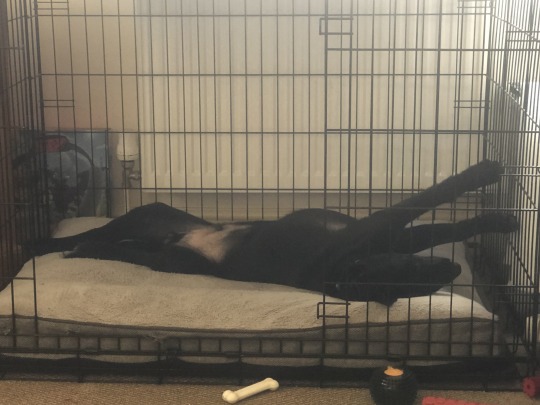
#rescue pup#*pops ‘he’s not aggressive’ streamers*#was a little shouty in his excitement at first#but then chilled out massively#and has the go-ahead for puppy class!#(yeah the meeting was supposed to happen last week)#(but her dog got overwhelmed the day before)#(so she decided it best to give her girl the day off)#(and this meant he’d be vaccinated enough to do it in the park)
14 notes
·
View notes
Text
First-Year Puppy Vaccinations
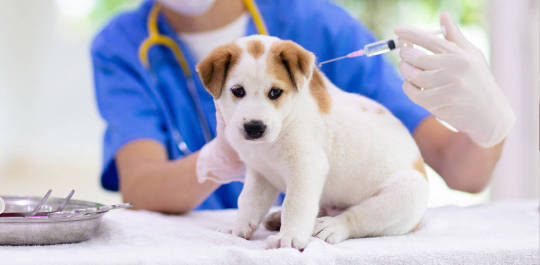
When you bring that fuzzy ball of puppy energy into your home, you know right away that your new puppy depends on you for, well, everything. It’s up to you to give your new puppy all the care they need every day. It can be a little intimidating — your puppy needs the best puppy food, plenty of attention, puppy training, puppy-safe toys, puppy socialization, a comfortable place to sleep, and proper veterinary care. And that includes making sure to schedule puppy shots throughout your puppy’s first year.
Which Shots Do Puppies Need?
Going to the vet over several months for a series of puppy vaccinations—and then for boosters or titers throughout your dog’s life—may seem inconvenient, but the diseases that vaccinations will shield our puppies and dogs from are dangerous, potentially deadly, and, thankfully, mostly preventable.
We read about so many different dog vaccinations, for so many different illnesses, that it can sometimes be confusing to know which vaccinations puppies need and which puppy shots are important but optional. Here is an overview of the diseases that puppy vaccinations will help your pet avoid.
Bordetella Bronchiseptica
This highly infectious bacterium causes severe fits of coughing, whooping, vomiting, and, in rare cases, seizures and death. It is the primary cause of kennel cough. There are injectable and nasal spray vaccines available.
If you plan on boarding your puppy in the future, attending group training classes, or using dog daycare services, often proof of this vaccination will usually be required.
Canine Distemper
A severe and contagious disease caused by a virus that attacks the respiratory, gastrointestinal (GI), and nervous systems of dogs, raccoons, skunks, and other animals, distemper spreads through airborne exposure (through sneezing or coughing) from an infected animal. The virus can also be transmitted by shared food and water bowls and equipment. It causes discharges from the eyes and nose, fever, coughing, vomiting, diarrhea, seizures, twitching, paralysis, and, often, death. This disease used to be known as “hard pad” because it causes the footpad to thicken and harden.
There is no cure for distemper. Treatment consists of supportive care and efforts to prevent secondary infections, control symptoms of vomiting, seizures and more. If the animal survives the symptoms, it is hoped that the dog’s immune system will have a chance to fight it off. Infected dogs can shed the virus for months.
Canine Hepatitis
Infectious canine hepatitis is a highly contagious viral infection that affects the liver, kidneys, spleen, lungs, and the eyes of the affected dog. This disease of the liver is caused by a virus that is unrelated to the human form of hepatitis. Symptoms range from a slight fever and congestion of the mucous membranes to vomiting, jaundice, stomach enlargement, and pain around the liver. Many dogs can overcome the mild form of the disease, but the severe form can kill. There is no cure, but doctors can treat the symptoms.
Canine Parainfluenza
This is one of several viruses that can contribute to kennel cough.
Coronavirus
The canine coronavirus is not the same virus that causes COVID-19 in people. COVID-19 is not thought to be a health threat to dogs, and there is no evidence it makes dogs sick. Canine coronavirus usually affects dogs’ gastrointestinal systems, though it can also cause respiratory infections. Signs include most GI symptoms, including loss of appetite, vomiting, and diarrhea. Doctors can keep a dog hydrated, warm, and comfortable, and help alleviate nausea, but no drug kills coronaviruses.
Heartworm
When your puppy is around 12-to-16 weeks, talk to your vet about starting a heartworm preventive medication. Though there is no vaccine for heartworm in dogs, it is preventable with regularly administered heartworm medication that your veterinarian will prescribe.
The name is descriptive — these worms lodge in the right side of the heart and the pulmonary arteries (that send blood to the lungs), though they can travel through the rest of the body and sometimes invade the liver and kidneys. The worms can grow to 14 inches long and, if clumped together, block and injure organs.
A new heartworm infection often causes no symptoms, though dogs in later stages of the disease may cough, become lethargic, lose their appetite or have difficulty breathing. Infected dogs may tire after mild exercise. Unlike most of the conditions listed here, which are passed by urine, feces, and other body fluids, heartworms are transmitted by mosquitoes. Therefore, diagnosis is made via a blood test and not a fecal exam.
Kennel Cough
Also known as infectious tracheobronchitis, kennel cough results from inflammation of the upper airways. It can be caused by bacterial, viral, or other infections, such as Bordetella and canine parainfluenza, and often involves multiple infections simultaneously. Usually, the disease is mild, causing bouts of harsh, dry coughing; sometimes it’s severe enough to spur retching and gagging, along with a loss of appetite. In rare cases, it can be deadly. It is easily spread between dogs kept close together, which is why it passes quickly through kennels. Antibiotics are usually not necessary, except in severe, chronic cases. Your vet may prescribe a dog-safe cough suppressant to help your dog (and you) get some rest, and some dog-safe throat soothers can help make a dog more comfortable.
Leptospirosis
Unlike most diseases on this list, Leptospirosis is caused by bacteria, and some dogs may show no symptoms at all. Leptospirosis can be found worldwide in soil and water. It is a zoonotic disease, meaning that it can be spread from animals to people. When symptoms do appear, they can include fever, vomiting, abdominal pain, diarrhea, loss of appetite, severe weakness and lethargy, stiffness, jaundice, muscle pain, infertility, kidney failure (with or without liver failure). Antibiotics are effective, and the sooner they are given, the better.
Lyme Disease
Unlike the famous “bull’s-eye” rash that people exposed to Lyme disease often spot, no such telltale symptom occurs in dogs. Lyme disease (or borreliosis) is an infectious, tick-borne disease caused by a type of bacteria called a spirochete. Transmitted via ticks, an infected dog often starts limping, his lymph nodes swell, his temperature rises, and he stops eating. The disease can affect his heart, kidney, and joints, among other things, or lead to neurological disorders if left untreated. If diagnosed quickly, a course of antibiotics is extremely helpful, though relapses can occur months or even years later.
Talk to your vet about when your puppy will be old enough for tick preventatives. Once your puppy is old enough, keep your dog on tick preventative medication, topicals, or wearables to help stop ticks from biting in the first place.
Parvovirus
Parvo is a highly contagious virus that affects all dogs, but unvaccinated dogs and puppies less than four months of age are at the most risk to contract it. The virus attacks the gastrointestinal system and creates a loss of appetite, vomiting, fever, and often severe, bloody diarrhea. Extreme dehydration can come on rapidly and kill a dog within 48-to-72 hours, so prompt veterinary attention is crucial. There is no cure, so keeping the dog hydrated and controlling the secondary symptoms can keep him going until his immune system beats the illness.
Rabies
Rabies is a viral disease of mammals that invades the central nervous system, causing headache, anxiety, hallucinations, excessive drooling, fear of water, paralysis, and death. It is most often transmitted through the bite of a rabid animal. Treatment within hours of infection is essential, otherwise, death is highly likely. Most states require regular rabies vaccinations. Check with your vet about rabies vaccination laws and requirements in your area.
Talk with your veterinarian about more information and guidance on necessary and optional vaccinations.
Puppy Vaccination Schedule
The first thing to know is that there is not just one puppy vaccination schedule for all dogs. Factors such as which part of the country you live in, and your dog’s individual risk factors will come into play. Some dogs do not need every vaccine. This decision is between you and your veterinarian. Always discuss puppy vaccinations at your regularly scheduled appointments.
That said, here is a generally accepted guideline of the puppy vaccination schedule for the first year.
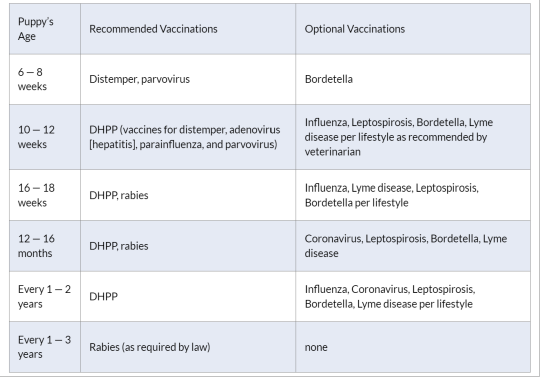
How Much Do Puppy Vaccinations Cost?
How much puppy vaccinations will cost depends on several factors. Where you live is a big one: Veterinarians in crowded and expensive urban areas will generally charge more than a rural vet in a small town. You may be able to find low-cost clinics providing rabies vaccinations sponsored by your local municipal government. But no matter what the range in costs, some vaccines, such as the “core vaccines” and rabies, are necessary.
The average cost can average around $75—100. These will include the core vaccines, which are administered in a series of three: at 6-, 12-, and 16 weeks old.
The core vaccines include the DHLPP (distemper, hepatitis, leptospirosis, parvo, and parainfluenza). Your pup will also need a rabies vaccination, which is usually around $15—20. (Some clinics include the cost of the rabies vaccination.)
Often animal shelters charge less for vaccines — approximately $20 — or are even free. If you acquired your dog from a shelter, he would most likely have been vaccinated, up until the age when you got him.
The initial puppy vaccination costs during the first year are higher than during adulthood.
Vaccinations for Adult Dogs: Boosters and Titers
There is a difference of opinion about having your adult dog vaccinated every year. Some vets believe too many vaccinations in adult dogs pose health risks. But others disagree, saying that yearly vaccinations will prevent dangerous diseases such as distemper. Talk with your vet to determine what kind of vaccination protocol works for you and your dog.
Many dog owners opt for titer tests before they administer annual vaccinations. Titer tests measure a dog’s immunity levels, and this can determine which, if any, vaccinations are necessary. One key exception to this is rabies: a titer test is not an option when it comes to the rabies vaccine. This vaccination is required by law across the United States. Your vet can tell you the schedule for your particular state, with boosters often lasting three years.
And it’s all worth it. For your effort and care your puppy will lavish you with lifelong love in return. This critical first year of her life is a fun and exciting time for both of you. As she grows physically, the wonderful bond between you will grow, too.
#puppy vacinations#puppy vaccines#puppy shots#puppy shots schedule#dog vaccinations#dog health#puppy health
5 notes
·
View notes
Text




Oh, yeah! I haven't posted her yet here, but @martias7 and I got a puppy! Meet Diana! She is 3.5 months old, so we've had her for about two months and she is Terminally Puppy.
#Diana Carmen#puppy#Coton de Tulear#dog#she is not feeling so great today :(#but she gets her last vaccine on Monday!
9 notes
·
View notes
Text
If you breed dogs I’ll fight you.
#fuck backyard breeders#I hate you so much#<- I’m just really tired. there’s so many dogs at the shelter. they’re so good. they’re vaccinated and housebroken and cost $500 to cover#everything#why would you spend 10000 just for an adoption fee without any of that? I love our dogs#fuck you backyard breeders fuck you.#fuck you purebred obsessors fuck you puppy mills FUCK YOU BREEDERS
5 notes
·
View notes
Text
There’s this guy in town who owns this little house, and a while back he rescued a street dog that was going to get put down. Turned out she was pregnant.
Problem is, he has mental health & drug issues and couldn’t afford to get them all spayed & neutered, so now there are 6 grown bitches with 15 puppies total, and they’ve dug under his fence in multiple places but he can’t afford to fix it so they go roaming all around town. (When I say can’t afford it, I mean his house is currently running on a generator because he can’t afford his electric bill.) He’s also a day laborer so he cannot take multiple full days off work to take them to the vet an hour away. He’s in a really rough spot.
He’s not a bad person. He’s just overwhelmed.
And this little conservative town with 6 churches for 300 people, have they tried to help their neighbor? Have they adopted the puppies he’s been trying to give away? Have they offered resources?
NOPE! All they wanna do is talk shit about him and complain about the dogs but never lift a finger of their own. And they come to his house to yell at him and cuss him out about the dogs, which does not exactly engender in him a cooperative attitude, as you might imagine.
So after a while of this going on, my mom gets fed up with all the NIMBY bullshit and starts talking to the guy, because she’s done animal rescue for 20-odd years and has Connections. He’s resistant at first, but when he realizes she’s not being an asshole to him on account of his addiction or the dogs, he decides to let her help.
She gets to work organizing and networking. Finds a non-profit that will cover vaccinations, spay/neuter, and flea treatments for all the dogs. Talks the next-door neighbor into paying for materials to fix the fence, since this guy can do the work of it himself. Gets him in touch with another non-profit that will adopt out the adult dogs.
Less than 2 weeks after she decided to do something, all puppies have been to the vet, 10 puppies and 4 adult dogs have been adopted out, and the second non-profit is coming by next week to pick up the remaining 7 dogs to ship them out for adoption.
I’ve learned a lot of things from my mom—some good, some bad—but I think the most important positive message she lives as an example of is this: sometimes, when something needs done and no one else is willing, you gotta stand up and say “I’ll do it.”
#dogs#animal rescue#liveblogging the texas hill country#pets#d’ye like dagss#true story#blog together queue alone
48K notes
·
View notes
Text
I love, so much, the mutual pestering license attached to having a dog
#she pesters me while I’m trying to get work done#i pester her when she’s looking cute#personalpost#i think it’s fair#she cost me most of my paycheck this month in (scheduled) vet trips :D#1000% worth it and I had built up savings for precisely this reason#my brother spent literally 3x as much on his puppy in unexpected vet bills the first week he had him#so when I told him he just said ‘welcome to parenthood’ lol#(both our dogs were adopted; he was mislead regarding his puppy’s vax status)#*misled#(VACCINATE YOUR PUPPIES GUYS. PARVO IS DEVASTATING AND EXPENSIVE.)#Lilahpost
1 note
·
View note
Text
Understanding Parvovirus in Pets: Symptoms, Prevention, and Treatment
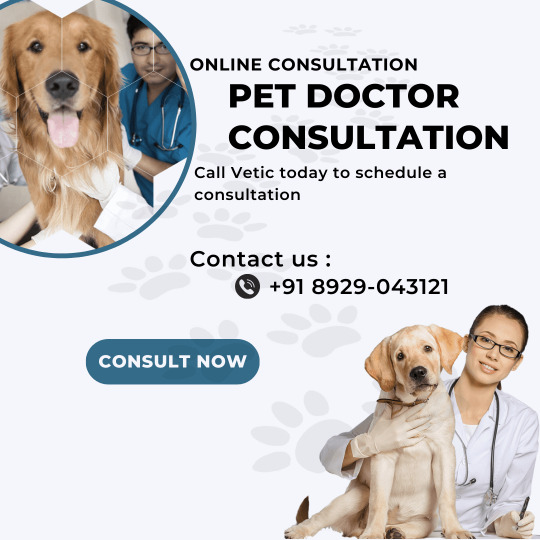
Parvovirus, commonly known as Parvo, is a highly contagious viral infection that affects many pets, especially young puppies and kittens. This article delves into the major symptoms, cures, prevention methods, and essential information on this dangerous virus. If you want to ensure your pet's health and safety, learning about Parvo and its impact on different animals is essential.
Visit Vetic to access expert veterinary care, diagnostics, and prevention tips for keeping your pet healthy.
What is Parvovirus (Parvo)?
Parvovirus is a life-threatening disease affecting mainly dogs, cats, and other mammals. Known for its rapid spread and high fatality rates, Parvo attacks the gastrointestinal and immune systems. Parvovirus is resilient, meaning it can survive in the environment for long periods and can be challenging to eradicate.
1. Pets Susceptible to Parvovirus
While Parvovirus is often associated with dogs, other animals can also contract it, though dogs are among the most vulnerable.
a. Dogs
Puppies and unvaccinated dogs are most at risk of Parvo infection. Breeds with higher susceptibility include Rottweilers, Dobermans, and American Pit Bull Terriers.
b. Cats
Cats can contract a similar virus, often referred to as feline panleukopenia. Although it's not the same virus as canine parvovirus, its symptoms and severity are similar.
c. Other Mammals
While uncommon, other mammals such as foxes and raccoons can also carry and spread Parvo.
2. Symptoms of Parvovirus in Pets
Recognizing the signs of Parvo early is crucial for effective treatment. Here are the most common symptoms seen in infected pets:
Lethargy: A noticeable decrease in energy and enthusiasm.
Vomiting: Persistent vomiting is a red flag, especially in puppies.
Loss of Appetite: Infected pets often lose interest in food.
Fever: An elevated temperature may indicate infection.
Bloody Diarrhea: One of the hallmarks of Parvo is severe, often bloody, diarrhea.
Dehydration: Constant vomiting and diarrhea can lead to rapid dehydration, putting the pet at even greater risk.
If you notice any of these symptoms, contact a veterinarian immediately. Parvovirus progresses quickly, and time is of the essence.
3. How Does Parvovirus Spread?
Parvo spreads primarily through contact with infected animals or contaminated objects, such as food bowls, bedding, and even human clothing. The virus is particularly resilient and can survive on surfaces and in soil for months. As a result, the risk of infection remains high if these areas are not properly disinfected.
4. Treatment Options for Parvovirus
Early intervention is key to improving an infected pet's chances of survival. Treatment for Parvo focuses on supporting the pet’s immune system and managing symptoms:
Hydration Therapy: Dehydration is a serious risk; intravenous fluids are usually administered to restore hydration.
Antiemetics: These medications help control vomiting and nausea.
Antibiotics: To prevent secondary bacterial infections, antibiotics may be prescribed.
Nutrition Support: Feeding support, often through an IV, ensures the pet maintains necessary nutrients.
Hospitalization: Most pets with Parvo require intensive care, making hospitalization essential for their recovery.
Since no specific antiviral exists for Parvo, supportive care is the best available treatment. Seek immediate help from a professional, like those available at Vetic, to maximize recovery chances.
5. Preventing Parvovirus in Pets
Prevention is far better than treatment, especially for Parvovirus. Here’s how to keep your pet safe:
a. Vaccination
Vaccination is the most effective way to prevent Parvo. Make sure your pet, particularly young puppies and kittens, receives their vaccinations on schedule.
b. Hygiene
Regularly disinfect your pet's toys, food bowls, and living areas. Be cautious when taking young, unvaccinated pets to public places.
c. Avoid Contact with Infected Animals
Keep your pet away from animals suspected of carrying Parvo. This applies to pet parks, shelters, and areas with high dog traffic.
d. Regular Vet Check-ups
Routine vet visits are essential to keeping your pet in good health. Vets can provide booster vaccinations and monitor for any early signs of illness. Visit Vetic for more information and to schedule an appointment.
6. The Importance of Parvovirus Awareness
Parvovirus remains a serious threat to pets around the world. Raising awareness about this disease and taking preventive steps can save lives. Ensuring your pet is vaccinated, keeping a clean environment, and seeking immediate care if symptoms appear are critical measures.
7. Why Choose Vetic for Parvovirus Prevention and Treatment?
At Vetic, we understand the love and commitment pet owners have for their furry companions. Our experienced veterinarians provide comprehensive Parvo vaccination programs, symptom management, and expert advice for prevention. With our state-of-the-art facilities and compassionate care, we are here to ensure your pet lives a healthy, happy life.
Visit Vetic today to learn more about our services and how we can help protect your pet from Parvovirus and other health risks.
#parvovirus#dog health#dog care#dog behavior#dog#animal#puppies#petlover#dog lover#pet#pet vaccination#pet vaccines#pet health#pet care#pet safety#pets
0 notes
Text
How much do puppy vaccinations cost?
Puppy vaccination costs typically range between $75 and $150 for the core vaccines in the first year. Core vaccines, like rabies, distemper, and parvovirus, protect your puppy’s health. Prices can vary depending on the vet, location, and whether you're getting a full vaccination package. After the initial series, annual booster shots or additional non-core vaccines, such as for Lyme disease or Bordetella, may cost extra, ranging from $15 to $50 per shot.
0 notes